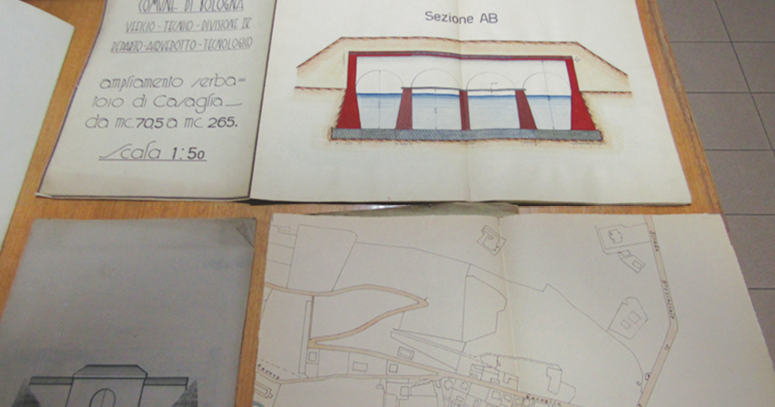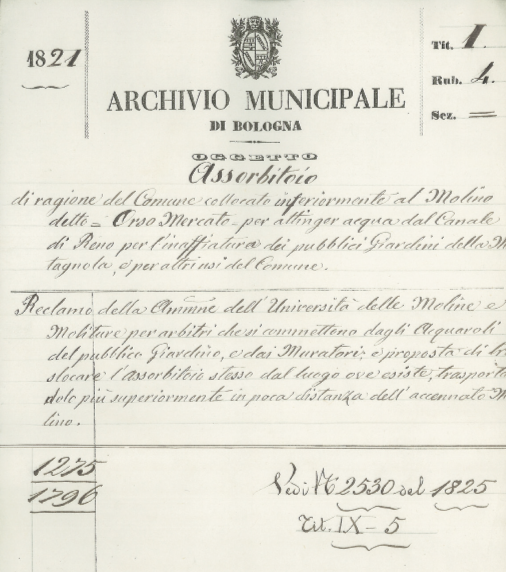The Historical Archives of the Municipality of Bologna house the documentation produced by the administration during the institutional activity of the city government. The main and most important archival corpus consists of the administrative correspondence written and received in the performance of the competent practices. The system that allows for the archiving of documents is called the Titolario, a classification system made up of predetermined categories that reflect the primary functions of the municipal authority. Today's classification system is represented in Roman numerals and includes the following subjects: I The Electorate, II Employees and Offices, III Convocations and Resolutions, IV Municipal Administration; V Treasury; VI Assets and Liabilities, VII Civil Status, VIII Cemetery, IX Troops, X Municipal Police, XI Public Hygiene, XII Aedility, XIII Public Works, XIV Education, XV Miscellaneous, XVI Charity.

In turn, the titles are divided into headings and sections that explore the particularities of the individual subjects. The wealth of archival sources offers the possibility of exploring multiple research paths within the complex and articulated cataloguing of the documentation. Crossing the consultation tools - indexes, protocols, inventories - there are diversified accesses with endless interpretations to deepen themes and subjects of great interest for city life. One of the primary objectives of the archives is to enhance the documentation to share and disseminate the great heritage preserved. Access to the institute is free: researchers, scholars, experts on a given subject, non-specialist public and above all citizens can come and learn about the depository of the urban history. A very fascinating subject of great interest for several studies and research relates to the waters that the archives have explored not only in the general themes but for the importance that the system has had relating to the hydraulics, the economy and the development of Bologna.
In this context, we propose some interesting facts concerning the everyday life of the city, the expression of a close relationship between citizens and administration. The exhibition of these original documents is successful because it involves the public not only for the particularity of the topics covered, but to understand the administrative correspondence, exploring the letters kept over time. Title I of 1821, heading 4, is dedicated to waters. A dossier has as its object: Absorbing place "of reason of the common," composed by the correspondence between the association of the mills of the street of the same name that presents a complaint against the improper use "of the Acquaroli of the public Giardino della Montagnola and the Muratori del Gioco del Pallone" that divert the waters of the channel forcing them to "leave the grinding."
And in 1865 the construction of a "conduit to be built on the Galliera road, against the small square della Pioggia, [...] to be used exclusively for getting rid of snow in the city." A complete and complex dossier filled with correspondence, drawings, tables, maps and estimates to illustrate an innovative and useful project.
On June 23, 1866, the Prison Administration wrote to the Mayor of Bologna: "Very often the Torrone prisons remain deprived of drinking water with consequential problems for prisoners and for services in general" and hopes that "the disturbance complaint does not have to happen again in the sole interest of the health of the detained family, of which the writer anticipates the utmost appreciation," signed by the Director Marchesini. Two days later, the mayor replied that "everyone is free to access the well in the "rustic" courtyard and that no exclusive rights are attributed to prisons” but is committed to consider the request.
The Torrone of the City Hall on the south-west side was the tower where the court and prisons were located.

At the end of the thirties of the twentieth century, "some interested people who live along the road from the Sanctuary to the South," having learned about the project of the San Luca aqueduct, "expressed their desire to enjoy the benefit of drinking water near their houses." The feasibility of the request is contained in the reply of the technical office of the municipality kept in the file of the overall expansion project of the Casaglia aqueduct.
The presence of the waters in Bologna can still be witnessed, these are just examples to experience the endless research paths of a documentary heritage that provides us with the meaning of a story full of surprises and discoveries.

.png)



.png)